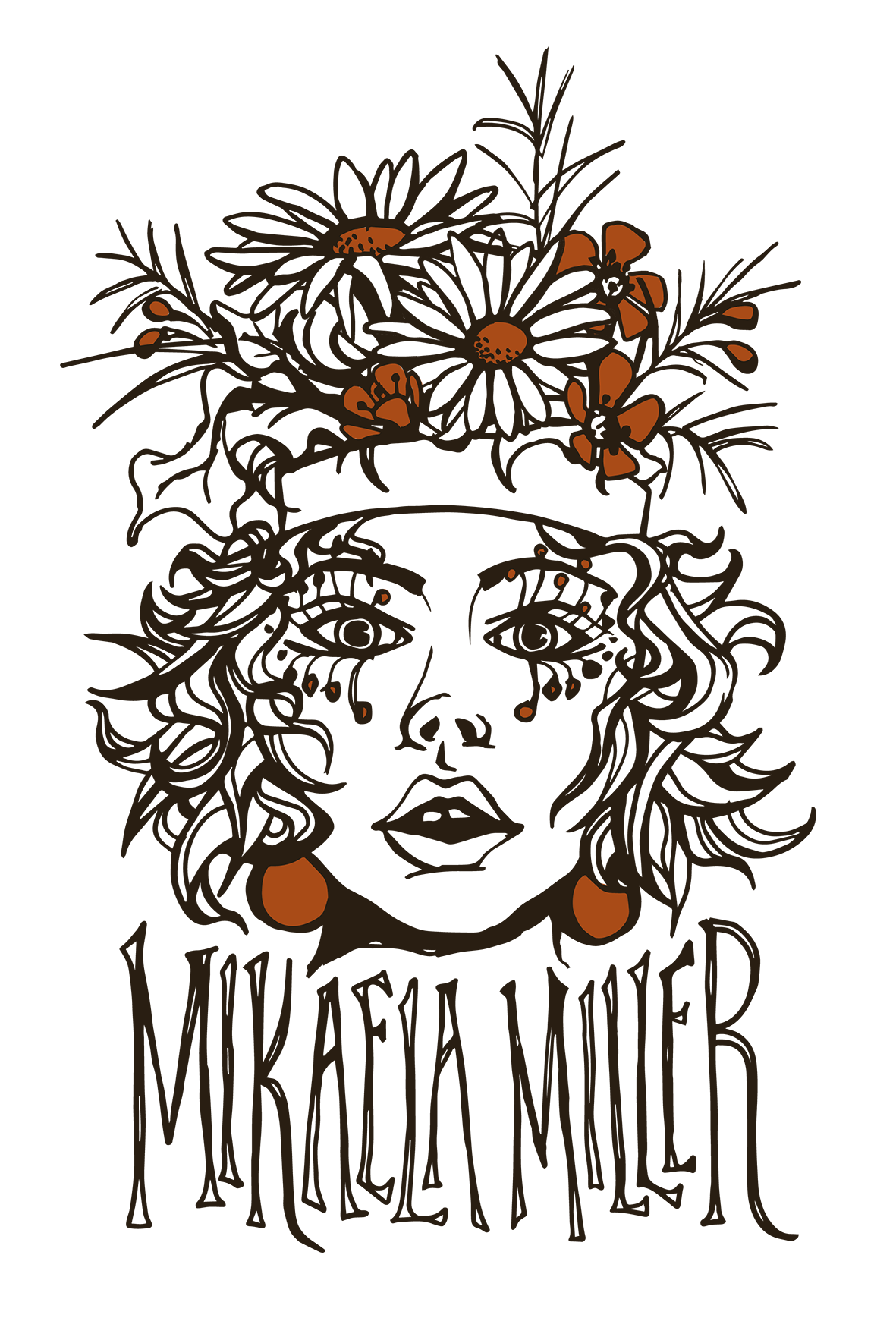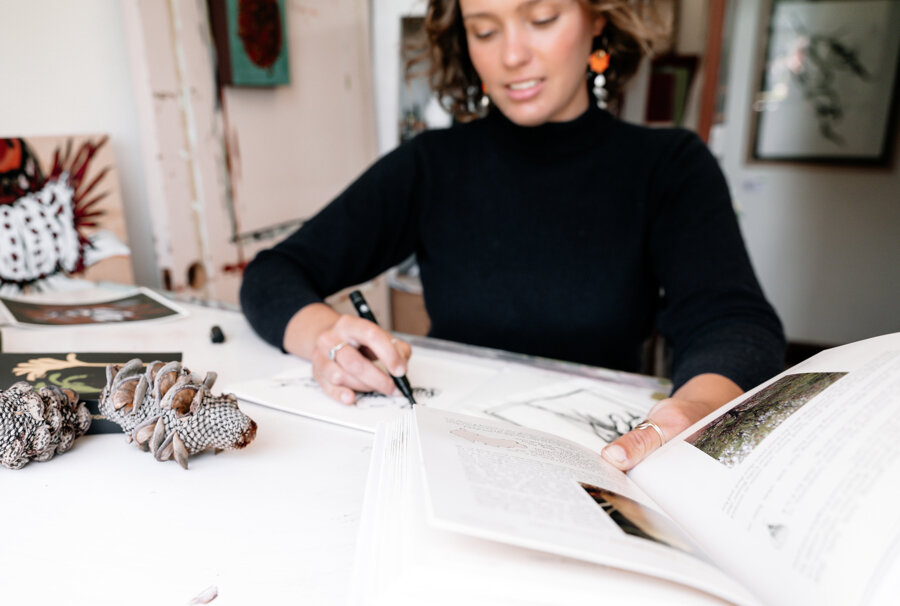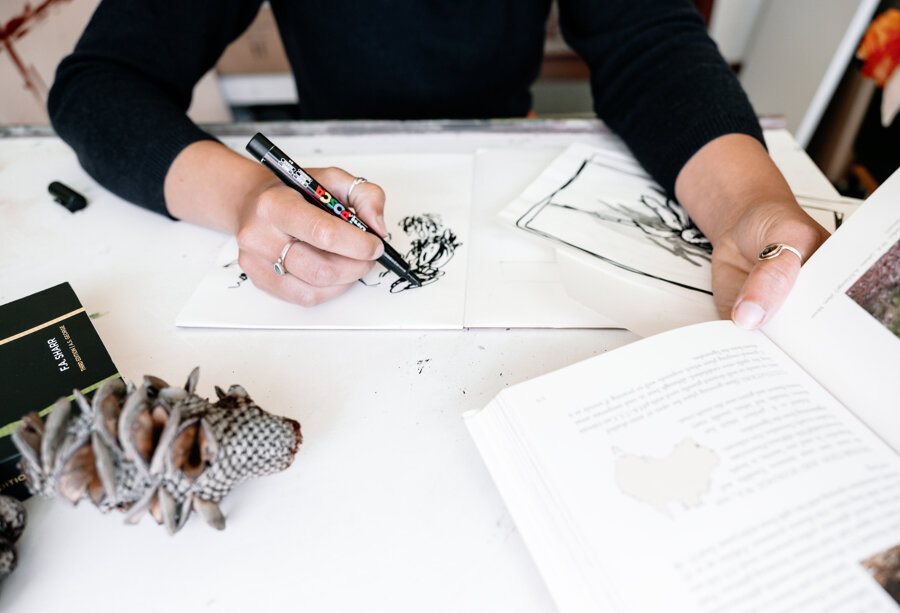The Language of Studio Practice
I recently celebrated my one-year studioversary. It has taken me that full twelve months to re-introduce myself to the language of studio practice, after five years of predominantly project [contract] work. Even still, I’m not quite forming full sentences, but I’m ready to start a clumsy conversation with you (if you’ve managed to keep up with this metaphor).
You see, studio practice is an entirely different way of making, compared to public art and commission-based projects.
For a start, commissions are guaranteed money. As a full-time artist, that makes a huge difference to how I prioritise my time.
We all have bills to pay, so work which promises to do that for me, naturally gets my attention first.
Given the choice between:
spending an afternoon messing around with some paint to see if the little squiggle I did in my sketch book actually does work in colour;
or spending an afternoon finalising the colour palette for an upcoming mural and then ordering the paint;
…I’m going to do the latter. The money is a promise. I promised to make the work, run the project and meet the deadline.
The client promised to (essentially) pay my rent. My experimental squiggly colour canvas promised nothing - not even that it would look good at the end.
That’s not to say my squiggle is less important than the mural. If anything, I SHOULD be prioritising those experiments and whims. They are the foundation of innovation, expression and often joy. Time spent playing, questioning, failing, reflecting and just making for the pure fun of it is crucial to developing our skills and voices as artists. That’s how we push our boundaries. That’s how we grow. That’s how we learn about ourselves and the world. Really, that’s the crux of art making. It just requires such a huge time investment, which is a big risk in a world where time is our most valuable resource.
Time spent playing, questioning, failing, reflecting and just making for the pure fun of it is crucial to developing our skills and voices as artists.
So, as a young artist, fumbling my way through running a business and entering the arts industry, I have sunk a LOT of time into building my skills, processes and network in the ‘project’ space. I have achieved a lot in that time. I think concentrating my efforts is the reason I have learnt so much and found some success there. In doing so, however, I really neglected my studio practice.
When I was at uni, there was a lot of advice around specialising. The thought was that if you are spreading yourself across too many things you’ll always be a “Jack of all trades, master of none.” What everyone failed to mention, was that you don’t have to specialise in only one thing and stick to that forever. One of the best parts about creative work is the diversity of it. I doubt any other industry gives you the opportunity to blend, pivot or evolve the way you can in the arts. There is plenty of opportunity to ‘master’ something and then add a complimentary component or start mastering another medium completely.
Once I figured that out, and had built enough of a foundation in my business to support some more risky time-allocation, I knew I needed to get back to making studio work. I’ve always fed my subject matter and ideas through different mediums, and each time my practice evolves a little. Illustrations became screen-prints, which became murals, which became lino-cuts, which became community workshops, which again became murals, and so the cycle continues. I think I now have enough of a handle on project work and running my business, that I can start to add back in some of these other components.
This past year at Goolugatup Heathcote, I’ve been trying to do some studio-sized paintings in the lulls between public art projects. I want to keep exploring line and the botanical world but I’m not convinced it always needs to be bright bunches of flowers. Painting canvases and boards seemed like an accessible way to play with what I’m already doing in my murals but zoomed in, paired back or pulled apart in some way.
There’s a new space somewhere just out of reach where I can show you exactly what fascinates me about plants - how they work, what they mean and their intoxicating details and textures. I think that space is getting gradually closer. Slowly. Slowly, I’m finding the ideas are developing, it’s easier to muster up the courage to play, the time put aside for just making is more productive, and the artworks are looking better at the end too. It’s still early days and I’m still feeling my way through… but I can sense more of a rhythm to it now. I’ll keep getting better at it as I go. So stay tuned for new works, new ideas, maybe something different to what you normally expect from my work - even the murals?
As a start, I’ll be releasing some prints in my shop, along with their original paintings, that have come out of this past year of making. I’m not convinced they are all the best versions of the ideas that birthed them… but these works are the phrases that stuck while I learnt the language of studio practice once again. I’m quite fond of them. Hopefully you will be too! They’ll be released over five weeks, starting in October (that’s now). Meaning they’ll all be available to purchase in time for Christmas.
If you’re on my mailing list, you can access them exclusively all at once. (You can subscribe below!)
I [evidently] am also starting this blog (which is probably going to be more like a journal). I thought, if I’m building a new community of humans with my new artwork language, this might help with the translation. The majority of my amazing community have, until now, followed my vast array of community projects and murals through my Instagram. Public work, made with the public, for the public - shared publicly. It’s all very public. Studio work is a bit more introspective and personal.
You don’t get to see how it’s made and there’s less to anchor your interpretation of the work. It’s not place-specific and it doesn’t have to meet a set brief or story.
This blog will give you a bit of an insight into my process, curiosities, inspirations and probably some random other stuff that’s influencing what I’m doing. It’s also going to be a great way for me to reflect on my practice as I go. To keep me accountable, make sure I’m always questioning what I’m doing and keeping track of what’s motivating the work.
Let’s see how it goes :)



